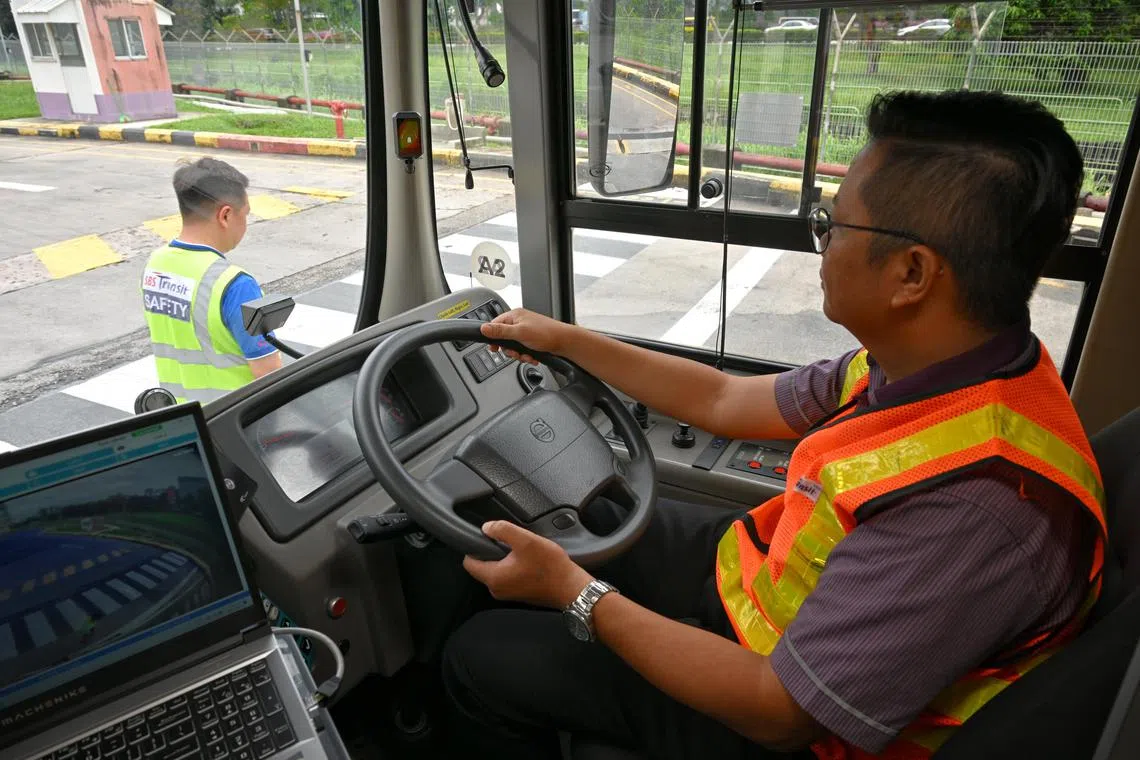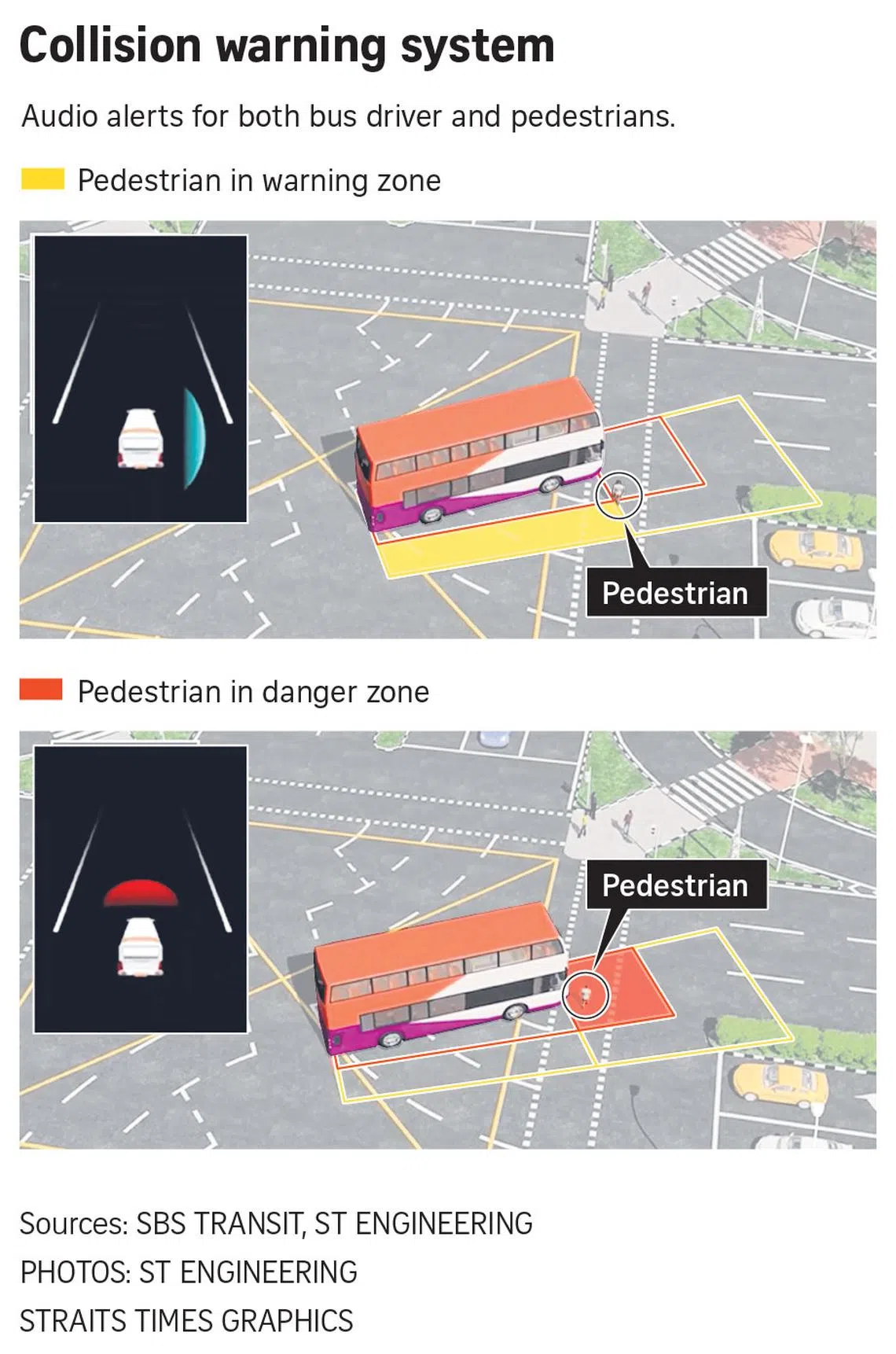‘Extra pair of eyes’: 360-degree collision warning system helps bus drivers check blind spots
Sign up now: Get ST's newsletters delivered to your inbox

Through cameras installed around the bus exteriors, the AGIL DriveSafe can detect vehicles and road users in blind spots.
ST PHOTO: SHINTARO TAY
Follow topic:
SINGAPORE - When Mr Tan Chee Kiong, a senior bus captain with public bus company SBS Transit (SBST), is at the controls of bus service 81, the roads are quite often clogged before Nex shopping mall and along the Kallang-Paya Lebar Expressway.
Besides turning his head to check his blind spots, and looking into the rear and side mirrors of his bus, the 39-year-old also has to keep watch for cyclists and motorcyclists who might suddenly get in the way.
He now has greater peace of mind as the bus he commands is one of 27 in SBST’s fleet fitted with a new collision warning system, Agil DriveSafe+, under a six-month pilot by the bus operator and technology and engineering group ST Engineering. The trial will end in mid-October.
The system is being tested on bus services 29, 40, 81 and 137.
Bus service 81, which Mr Tan serves, covers areas such as Tampines, Pasir Ris and Serangoon.
The initiative – which SBST and ST Engineering described as the first 360-degree advanced collision warning system to be tested on buses here – was unveiled on May 24 at Bedok North Bus Depot.

A demonstration of Agil DriveSafe+ on a bus approaching a commuter at the Bedok North Bus Depot.
ST PHOTO: SHINTARO TAY
Speaking in Mandarin, Mr Tan said: “It has two pairs of eyes, while I have only one.”
The key features of the system include four wide-angle cameras around the bus which detect pedestrians or vehicles in a driver’s blind spots.

One out of four cameras atop the bus to detect vehicles and road users in blind spots.
ST PHOTO: SHINTARO TAY
Video analytics technology and artificial intelligence are used to distinguish between pedestrians and vehicles.
Through machine learning, the system can also differentiate between roads and pavements, thus separating a pedestrian on the road who may be in danger of being hit from one waiting at a bus stop. This prevents false alerts to the bus driver, which can cause further distractions.
Once the sensors detect pedestrians or vehicles in a blind spot, drivers will be alerted through a display installed in front of them. There will also be audio alerts from a buzzer above when the sensors detect vulnerable road users, such as pedestrians or cyclists.
These road users are also alerted via a blinker and buzzer on the side of the bus if they come within 4.3m of the bus.
The alerts will sound only if the bus is moving.

A red LED blinker on both sides of the bus to alert pedestrians.
ST PHOTO: SHINTARO TAY
This system also includes similar features already present in Mobileye,
Like Mobileye, Agil DriveSafe+ has a headway monitoring feature, which calculates – in seconds – how near a bus is to the vehicle in front of it.
When the vehicle in front is two seconds or less away, the driver receives an alert via the display and an audio alert.
Like Mobileye, Agil DriveSafe+ can detect lane markings and alert bus drivers if they change lanes without signalling.
“When Mobileye was started in 2014, (the) technology at that point in time was relevant. Today, after so many years, I think this is when we want to explore new technologies and features for a better system,” SBST’s bus business chief executive Lim Tien Hock told reporters.
When asked about the bus company’s roll-out plans for the new system, Mr Lim said it will depend on the outcome of the six-month trial.
To assess its effectiveness, surveys will be done with bus drivers who will be asked to rate the system and their different features. There will also be one-to-one sessions to seek feedback from bus drivers on how to improve the system.
Mr Hoe Yeen Teck, head of mobility road and services at ST Engineering, said its engineers would review recordings of bus journeys during the trial.
They are aiming for an accuracy rate of above 95 per cent in terms of correctly identifying vulnerable road users such as pedestrians and vehicles in blind spots. The present accuracy rate is 95 per cent.
Mr Lim said that if bus drivers find the system effective, a few other bus services may be selected to start on a second phase of the testing after the trial ends in mid-October.
He declined to disclose the cost of the system, citing the fact that it is a “commercial arrangement”.



